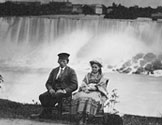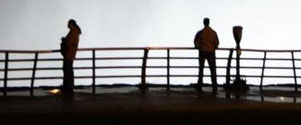

|
||||||||||||||||||||||||||||||||||||||||||
|
| ||||||||||||||||||||||||||||||||||||||||||
 |
 |
 |
 |
 The First Voting Machine With the memory of another election still fresh in our mind, Niagara County citizens can take comfort in knowing that in 1892, we were “first in the nation” to use lever operated mechanical voting machines. The history of voting in Niagara County pretty much follows the trend of all voting in this country- from paper ballots or “tickets” to mechanical voting devices. The invention of the later is credited to Jacob Meyers, who operated a company that made safes in Rochester, NY. His introduction of the Meyers Automatic Voting Booth set the course for a trail of successors that even today, follow his model. Meyer’s voting machine used many of the same security measures he built into his safes, and in many ways, the first voting machines resembled a large vault, about ten feet square containing two doors at the front and no windows. The voters would enter through the door on the right. The poll watcher would then close and lock the door while with the aid of kerosene lamps for lighting, the voter pressed in a series of knobs next to the names of their candidates. When finished, the voter would exit through the door on the left and slam the door shut. This process would lock the exit door, record the vote and release the lock on the entrance door, allowing the next voter to enter. Meyers declared that his new voting machine would “protect mechanically the vote from rascaldom and make the process of casting the ballot perfectly plain, simple and secret.” The first application of the Meyers machine in the United States came on April 15, 1892 in the Town of Lockport when at 8:45 AM, incumbent supervisor, John G. Freeman, entered the machine and cast the first mechanical vote for his own re-election. The “Lockport Union” reported that six persons voted in the first minute-a truly remarkable feat. For the benefit of those who could not read, the slate of candidates for each party were printed in different colors-yellow for Democrats, red for Republicans and blue for the Prohibition Party. The newspaper went on to report that the voting was “unquestionable, untrammeled, uncorruptible and correctly counted.” (It would be safe to presume there were no “hanging-chads.”) Within a minute after the polls closed at 5:30 PM, the re-election of Supervisor Freeman was announced and within minutes, the name of every other successful candidate was also known. It was a remarkable feat in a day and age when voting results usually required many hours or days of counting paper ballots by hand. Even after its first successful use, acceptance of the “new-fangled voting contraption” proceeded slowly and it was not until 1918, some 26 years later, that the City of Lockport purchased its first machine. At that time, the cities of Niagara Falls and North Tonawanda and the towns of Royalton and Wilson were already voting by machines. The other towns were still counting paper ballots and it was not until 1937 that the last two towns, Cambria and Somerset; bought machines, bringing an end to the use of paper ballots in Niagara County. Douglas Farley, Director Ann Marie Linnabery Erie Canal Discover Center 24 Church St. Lockport NY 14094 716.439.0431 CanalDiscovery@aol.com www.NiagaraHistory.org |
|